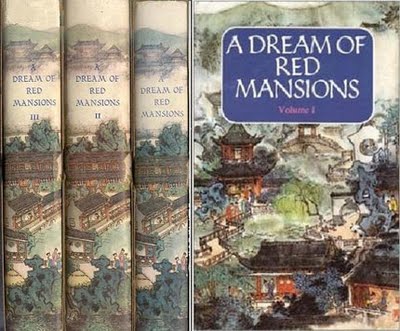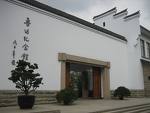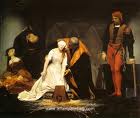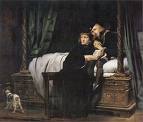
The death in November last year of Yang Xianyi, the 93-year-old veteran translator marked the end of an era in terms of the transmission of Chinese culture to the West. Lengthy obituaries hailed the achievements of this most prolific of translators, who together with his English wife Gladys (pictured above) produced over 60 books of translations of the Chinese classics, ranging from the 4-volume
Selected Works of twentieth century novelist Lu Xun to the lyrical poem from the fourth century BC
Li Sao and from the works of post-Mao writers to the vast eighteenth century novel
The Dream of Red Mansions.
The lives of Yang Xianyi and Gladys Yang read like a film script and it is hard to think that any of the new generation of translators will live through such turbulent and extraordinary times. The grandson of a senior provincial governor and the son of a Bank of China official in the city of Tianjin, who amassed a fortune partly through dealings with warlords, Xianyi was at first educated in the Chinese classics and then sent to a British missionary school where most of the classes were in English. There he immersed himself in English literature, translating Milton into classical Chinese verse, before conceiving of the desire to learn Latin and Greek, which brought him in 1936 to Merton College, Oxford.
After two years he switched to studying French literature and finally English literature, taking tutorials with the poet Edmund Blunden. He was hardly a star pupil however, spending liberally and travelling extensively, and generally acquiring the reputation of a playboy. He did find time however to set up an anti-Japanese Chinese newspaper and, thanks to the Oxford China Society, fell in love with Gladys Tayler, the first undergraduate to study Chinese at Oxford. He finally emerged with a fourth-class degree, which he referred to as 'a rare beast'.
Gladys was the daughter of missionaries in China and had spent her early childhood in Beijing before being packed off to boarding school in England. Both of their families were horrified at the thought of their inter-racial union, but nevertheless they returned to China in 1940 and married in the wartime capital of Chongqing, then under the control of Chiang Kai-shek's nationalists. After the defeat of the Japanese they moved to Nanjing, working as English teachers and translators.
With the fall of the Nationalist regime in 1949, the couple were offered a means to escape to Taiwan, but elected to stay on in communist China and moved to Beijing where by 1952 they were working for the Foreign Languages Press, entrusted with the daunting task of translating the major works of Chinese literature into English as well as producing translations of many propaganda pieces. In his spare time Yang Xianyi also worked on translations, somewhat frowned upon by his communist overseers, of Western literary classics such as Homer's
Odyssey, the works of Aristophanes,
The Song of Roland and Bernard Shaw's
Pygmalion into Chinese.

By the 1960's, the Yangs had already produced amongst many other translations,
The Selected Works of Lu Xun, the Qing dynasty novel
The Scholars and had commenced work on
The Dream of Red Mansions. They had two daughters and a son and became mentors to a stream of westerners who came to Beijing to study or teach. But disaster struck when in 1968 they both fell victim to the turmoil of the Cultural Revolution (1966-76) and found themselves thrown into prison for four years. Gladys was kept in solitary confinement while Xianyi shared a grim cell with a mixture of criminals and political prisoners. Neither knew anything about the other's fate and Gladys' mother in England died not knowing what had happened to her daughter.
Finally released in 1972, the couple resumed their translation work, but further tragedy lay ahead. As part of the Cultural Revolution, their children were sent to work in factories or communes in distant provinces and their son Yang Ye began to suffer mental health problems, rejecting the Chinese around him and wishing only to associate with English people. After with difficulty obtaining a visa allowing him to go to the care of family members in London, he committed suicide there in 1979, a tragedy from which Gladys never fully recovered.
In the 1980's the Yangs' home became a salon in Beijing where Chinese and Western writers and intellectuals gathered to freely discuss ideas over copious amounts of gin and whisky. Gladys set about translating the works of a new generation of post-Mao writers and became interested in the Women's Movement, translating the works of Chinese women writers. For a time there was a relaxation of government control and a new openness and in 1985 Yang finally joined the Communist party. But immediately afterwards a reaction set in leading to the massacre of Tiannamen Square in 1989. Xianyi courageously spoke out against the atrocity, comparing China's leaders to fascists, worse even than the warlords of the past or the Japanese invaders.

Gladys passed away aged 80 in 1999. The following year Xianyi published his autobiography
White Tiger. He was awarded an honorary doctorate by the University of Hong Kong who praised him as a 'master translator'. On September 17 2009, shortly before his death, the Translators Association of China bestowed upon him their Lifetime Achievement in Translation Award with the words 'he is second to none among Chinese translators in terms of quantity, quality and influence'. After his death, John Gittings commented in
The Guardian that 'tens of thousands of foreign students of Chinese, from then till today, have relied on their work' and the anonymous obituary writer of
The Times agreed that 'they produced a steady stream of translations of very high quality'.
There's seems no doubt then from all the available evidence that the Yangs were extremely good eggs - their hearts were in the right place, they were incredibly diligent and productive, kind, open and unstuffy. In the face of constant political oppression, they were fearless and suffered a great deal in order to be able to devote their lives to the translation of Chinese literature and make accessible that vast continent of knowledge to readers in the West.

For all these reasons, you can't help admiring them. However there is a flip side, which somewhat awkwardly and reluctantly, I feel obliged to point out. The simple fact of the matter is that Chinese literature is still virtually unknown in the West and, apart from students of Chinese, hardly anyone would consider reading these scores of government-backed translations.
The Dream of Red Mansions, for example, is one of the great books of world literature, yet how many people in the West have the slightest idea about its contents?
What is the reason for this? When Mao first met Xianyi and heard that he had translated the long poem
Li Sao, he expressed scepticism that the poem could be translated, but Xianyi replied that 'I think everything can be translated'. Not everyone however was so convinced. David Hawkes, a friend of Xianyi's, who did his own translation of
Li Sao (as well as his own version of
Red Mansions) offered the opinion that the translation 'bears as much resemblance to the original as a chocolate Easter egg to an omelette', a remark which apparently amused Xianyi.
My own perspective on the Yangs is unfortunately very different to all the gushing praise of the obituary writers. One of my great literary heroes is Lu Xun, a bust of whom adorns the mantelpiece of my home. He is someone whose work I became familiar with ten years ago when I was PhD student in Japan. Lu Xun is every bit as well known and critically lionized in Japan (where he is known as 'Rojin') as he is in China and has been since his works were first translated into Japanese in the 1920's.

Fascinated both with Lu Xun's life story and his literary works, I made some years ago the pilgrimage to the Lu Xun House and the vast Lu Xun museum (pictured left) in Shanghai. Here I bought the 4-volume
Selected Works of Lu Xun in English translation by the Yangs. But upon turning its pages, my heart sank at how leaden and uninspired these translations were. I struggled through volume one before abandoning completely the other three volumes. If this was what I had to go on, I could see nothing at all of interest about Lu Xun's writings, despite his being widely regarded as the greatest writer of modern China.
And yet I am sure that the writings of Lu Xun are some of the greatest of the twentieth century. But I can only say this with confidence because I have been able to read stories such as 'The True Story of Ah Q' and 'Diary of a Madman' in Japanese translation, sometimes comparing it with the Chinese original. Reading them in the Yangs' English translation was an entirely different, dispiriting experience, in which all the richness and savage wit of the original was completely lost.
At the time I had no idea who 'Yang Xianyi and Gladys Yang' were, but merely thought of them as a classic example of the perils of collaborative translations. As in some old-fashioned translations of the Japanese classics where a Japanese person did a first draft that was liberally rewritten by a Westerner who could not even read the original, I could only mistakenly imagine that this was the case here also and that 'Xianyi' had done a first draft into unintelligible English before it was tidied up into readable, if tedious prose by 'Gladys'. I marvelled that a pairing so lacking in talent could have the audacity to produce a full 4-volumes of translations by the great Lu Xun. Little did I know that this was just the tip of the iceberg as regards the enormous translation output of the Yangs.
And some years later when I was in Hong Kong and browsing in an English language bookshop, I thought of seeing if I could lay my hands on a translation of that greatest of Chinese novels,
The Dream of Red Mansions, but discovered to my horror that there again were names 'Yang Xianyi and Gladys Yang'. I did not buy the book, but muttered to myself what induced these people to keep on churning out such translations.
Of course now, knowing the full history of the Yangs and everything they went through to produce these translations, I feel acutely embarrassed at my ungratefulness with regards to their heartfelt and herculean labours. But that does not change my strong suspicion that most of their translations were rapidly produced and of questionable quality. Yang Xianyi was I am sure an amiable, amusing and erudite man, and a robust believer in political freedom, but I suspect that there are good reasons both why he emerged from Oxford with a fourth-class degree and why so few people in the West read his translations.
To my mind the great Western discovery of the Chinese classics is a task that still lies ahead and that hopefully next time will be taken out of the hands of state controlled publishers in Beijing and entrusted instead to visionary publishers in the West and first rate academics and writers both with an appreciation for the complexities and subtleties of Chinese and a flair for the English language. Modern couples like Chinese novelist Ma Jian and his English translator wife Flora Drew might be better equipped to bridge the cultural and linguistic divide.
China cannot go on being the cultural elephant in the room, but is now a presence in the world that none of us can ignore. That journey of understanding has to start with the country's literature and its rendering into fresh translations that fully communicate the richness of ideas, colour and passion of the original masterpieces.

 is an eerie fantasy meditating on the nature of time and history, where a Japanese visitor to the Tower of London spies the ghost of Lady Jane Grey and the blood-splattered climax of the story is a re-enactment of Delaroche's picture. Not only that, but Soseki actually includes a re-enactment of another Delaroche painting The Princes in the Tower (pictured right) in the same story.
is an eerie fantasy meditating on the nature of time and history, where a Japanese visitor to the Tower of London spies the ghost of Lady Jane Grey and the blood-splattered climax of the story is a re-enactment of Delaroche's picture. Not only that, but Soseki actually includes a re-enactment of another Delaroche painting The Princes in the Tower (pictured right) in the same story.  most important Japanese writer of the modern age and his story 'The Tower of London' was one of his breakthrough works. There seems however only to be space for books on the history of the Tower of London or Tudor history or pop-up books for children. Trying to persuade the Tower of London shop that they might also have room for a world literary classic and you descend into a Kafkaesque world of bureaucratic jobsworthiness. My dear sir, to have a book sold at the Tower of London shop you must first submit an application to Her Majesty's Palaces, whereupon the book will be scrutinized for its worthiness, suitability and public appeal...and so on and so on.
most important Japanese writer of the modern age and his story 'The Tower of London' was one of his breakthrough works. There seems however only to be space for books on the history of the Tower of London or Tudor history or pop-up books for children. Trying to persuade the Tower of London shop that they might also have room for a world literary classic and you descend into a Kafkaesque world of bureaucratic jobsworthiness. My dear sir, to have a book sold at the Tower of London shop you must first submit an application to Her Majesty's Palaces, whereupon the book will be scrutinized for its worthiness, suitability and public appeal...and so on and so on. 



